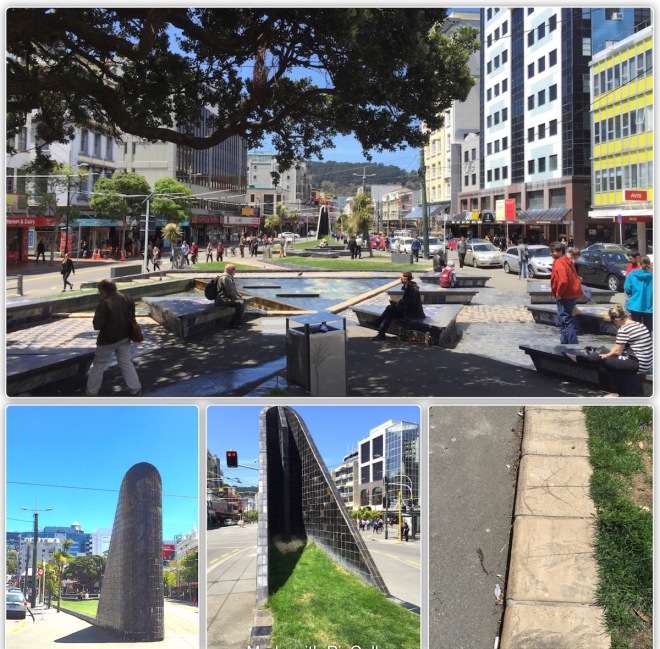I think Te Aro Park is the largest art project in the city. Civic Square, or Te Papa, or the wind sculptures at the airport, or the waterfront itself – they are not a concept in themselves.
Most people don’t realise that Te Aro Park is artistic concept – the entire park is a ship sailing into the Courtney Place.
The prow is nudging the biggest intersection in Wellington – Taranaki Street, Courtney Place, Dixon Street and Manners Street. The ship extends on the angle between Dixon and Manners Streets and the shopping area west of the park is really the bulkheads of the boat. The forecastle is the park with triangular water features, triangular benches, trees and triangular grassy areas. On a good day, many people relax and recuperate, partake of the lunches, or a takeaway coffee from any number of cafes in the area.

Some of the tiles lining the paths have native trees leaves imprinted on them. On the cross-wise central path there are block letters in Māori. I think they are describing the local and regional kai and pa:
WAI KIE KIE PAPAKA WHERO TUTAI WERA OMARU KAIURU MATA KI KAPOUNGA KAI TARA WARU KAU WHAKWHARU TE MAHANGA TE KARAKA KAKI RIKI KIRIKIRI TANGI TUTEREMOANA TE RAINGAA O KUPE
PIPTEA, WAI TANGI, KUMOTOTO, WAIKUMIKUMI, TE ARO, HURIWHENUA, WHATAITAI, KAI UPOKO, TAWA TAWA, WAI PAPA, WAI KOU KOU, WAI HEREHERE, PUKE HINAU, OWHIRO, TE RANGI A HIWI, TE AU A TANE, WHANGANUI A TARA, MATAIRANGITANGI TE KEO, TE ARO ARO A KUPE
The prow is ceramic tiles with a rainbow sheen on them, like tungsten. Inside, there is another karakia:
WAITAHA, TE TINI O MAMOE, NGATI MAMOE, NGAI TAI, KAITAHU, NGATI IRA, NGATI MUTUNGA, TE ATI AWA, MA TE WAHINE KA TUPU A I, TE HANGA NEI, TE TANGATA, ME TE WHENUA KA WHAI, TE ORANGA AI
Any clues or translation? (Google Translation has a lot of sheep, burning, prisoners and heaven’s hull – basically goobledygook!)
A plaque (triangular as well) on one of the benches details the history of this park:
Te Aro Park
This was the site of the Te Aro Pa, settled by the Te Atiawa people, up to the 1890’s. By 1845 the Wesleyan Church had erected several buildings including a Mission House and Māori Chapel. The park has also been the site of police, fire, electrical stations and Turkish Baths. In 1925 the site became Market Reserve, and in 1939 the stone memorial was erected to commemorate the 1839 Christian service at Te Aro Pa between the Māoris [sic] and Methodist Church missionaries. In 1989, planning of the site as a sculptural park was begun by the Wellington City Council. NZ Ceramic Artist Shona Rapira Davies was commissioned to design the park, in conjunction with the WCC Landscape Architect, and to then prepare artwork and manufacture of the tiles. The park was completed and opened in May 1992.
Symbolic features of the park include:
~ Water representing the life principle of cleansing, blessing and renewing. It flows diagonally across the site and reflects the Te Aro stream and original shoreline.
~ The pools with female figures represent the three generations of women: old women, young women and young girls.
~ The strong horizontal elements of the walls form weaving patterns and symbolise the female principle.
~ The prow and other vertical elements symbolise male priciples. Only men were allowed to paddle the war canoes.
~ The nine kowhai trees are symbolically placed to represent the oarsmen of the canoe.
I can’t see any kowhai trees now – maybe they have expired?
But some fine ti kouka (cabbage trees) are flourishing and a magnificent pōhutukawa tree shades the lunch-makers from the sun.

